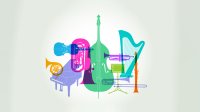How Integrating Different Music Traditions in the Classroom Can Enrich Learning
Culturally significant music can enhance lessons across several disciplines while building classroom unity.
Your content has been saved!
Go to My Saved Content.Music is called a lot of things—art, a feeling, and a source of healing, to name a few. From our bandstand here at Preservation Hall in the French Quarter of New Orleans to classrooms across the country, we’ve learned that music is not just one thing, but many things. It’s as nimble as it is accessible. It can cross over all grade levels and subject areas, making it a powerful tool for any teacher. This is particularly true with historically and culturally significant music.
We take an intergenerational approach to teaching—meaning that we believe the generations before us and after us can learn from one another. It’s a fun and easy way to introduce musical traditions in the classroom. Anchoring a lesson or class meeting with this approach can build community, enhance creativity, and embrace cultural identities.
Building Community
Think for a moment about what happens when you hear music playing. Whether it’s a marching band at a pep rally or a catchy jingle in a student’s presentation, you’ll notice something special: It gets everyone’s attention. Some students are moving to the beat, while others are observing. Whichever way the music is spread or received, it unites.
We follow three simple rules for building community with historically and culturally significant music: listen to music often, create music collectively, and go on musical excursions.
The music of our past is an excellent equalizer for understanding the present. Listening to traditional music together expresses feelings, such as joy, sadness, or anger. It can be soothing or encouraging, a messenger and a connector. Rhythms, movements, and genres of all types bring people together. We like to use “Keep Your Head Up” as an example of two cultures coming together for a mutual reason. It also makes for an excellent class motto!
Traditional music also supports collaboration, or as Louis likes to say, “collective creation.” You can perform it, debate it, or remix it, depending on the subject you teach.
If you’re an instrumental educator, teach students to work cooperatively with songs passed down from another generation. Creating combined sounds gets students to learn in unison while fulfilling their individual purpose. If you’re not a music educator, think about using diverse musical traditions as a classroom management tool during transitions or as inquiry-project resources for gathering information about a particular period, historical figure, or event.
We also recommend getting out of the school building to experience musical excursions with your students. Here at the Hall there’s no escaping a good time; we bring students together for an immersive and bonded musical experience.
This type of field trip is rich with history and expands into incredible cultural learning blocks. Look in your immediate or neighboring communities for organizations that celebrate and protect musical traditions. When you simply discover these things together, music will strengthen your social bonds.
Enhancing Creative Tasks
Music of any genre invigorates the mind and body. In New Orleans alone, we can integrate gospel, traditional jazz, Caribbean, Cajun, zydeco, rhythm and blues, African drumming, and other genres to inspire new work.
As you plan, seize the moment to show students how traditional music is connected to everything: visual arts, theater, dance, language, social studies, and math (yes, even algebra!). We enhance our instruction through this type of connection, teaching students how to multitask, improvise, and access multiple intelligences to create something new out of something old.
One way we do this is by tying traditional music to very basic topics taught in most schools, such as cultural customs, historical eras, mathematical patterns, or current events. A song like “When the Saints Go Marching In” can teach literary themes like redemption. Clave rhythms (a repeated rhythmic pattern) can turn into a history lesson, and djembe sounds (bass, tone, and slap) can jump-start a geography unit.
Another practice we use is intersecting music with other art forms. Musical traditions from other cultures can activate the imagination. It’s inspired future dancers, visual artists, professional musicians, content creators, and cultural scholars. The approach pays tribute to the music of our past and creates divergent thinkers for the future.
Embracing Cultural Identities
Every student has their own distinctive identity, much like a fingerprint. Welcoming historically and culturally significant music honors the differing identities we see among our student population. Tapping into these roots with diverse sounds is a great way to create an inclusive classroom climate. We’ve done this by exploring musical heritage and soundtracking stories.
Start by discovering your musical heritage, followed by your students’ musical heritage. It’s a nice icebreaker (try it in a staff meeting, too!) and encourages students to absorb how and why music relates to everyone and everything. Locally, we have a rich tapestry of cultures, but any student from any school can discover their own tapestry. This activity can help explain how individual and collective identities are formed.
Soundtracking is another option. This is when you curate a list of songs related to a topic, such as identity. It can be biographical, link to memories, or be a pathway to self-expression. Whichever activity you choose to soundtrack, think of it as an opportunity to show and demonstrate support for your students. This will develop the type of cultural competence needed for the growing diversity we see in our student body.
Putting it All Together
Historically and culturally significant music is not just a part of our past, but the future. Shared music experiences create the positive communal environments we wish for. They inspire learners to be creative risk-takers and help us understand our students more deeply than what a standard curriculum can offer. One of our visiting teachers once said, “You can actually feel the history around you,” and what better way to make sense of the present?
